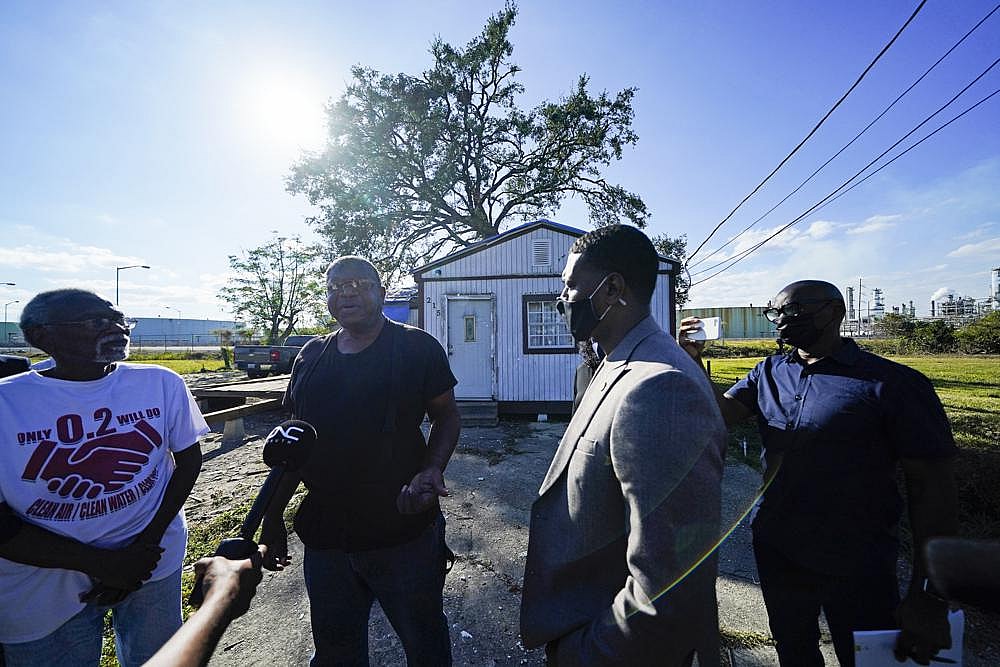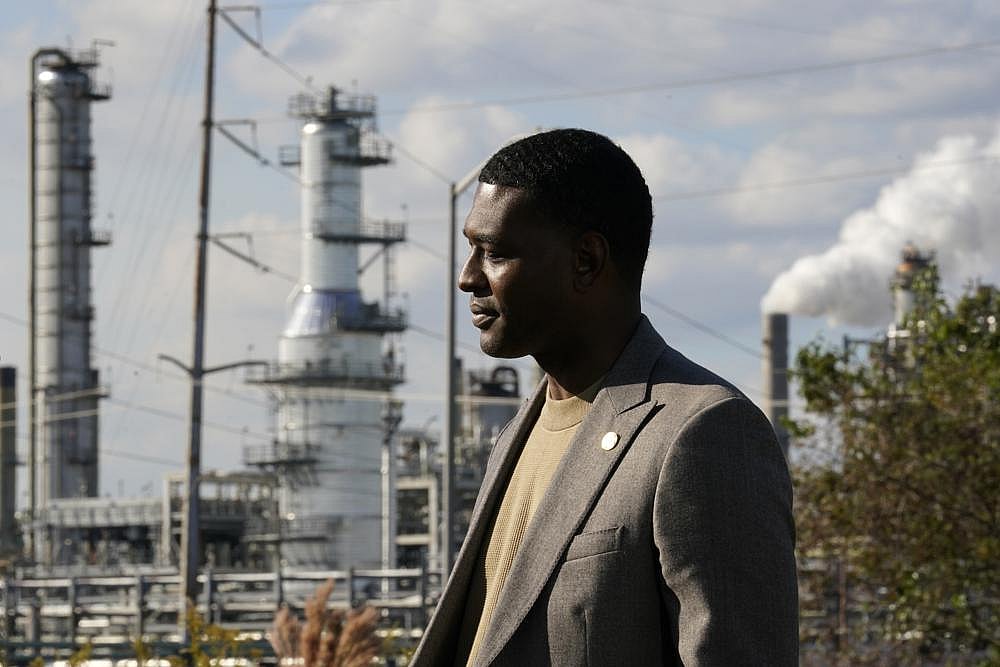Michael Coleman’s house is the last one standing on his tiny street, squeezed between a sprawling oil refinery that keeps him up at night and a massive grain elevator that covers his pickup with dust and worsens his breathing problems.
Coleman, 65, points to the smokestacks billowing just outside his backyard. “Oh, when the plants came in, they built right on top of us,” he said. “We was surrounded by sugarcane, and now we’re surrounded by (industrial) plants.”
The oil company offered him a buyout, but Coleman rejected it. “I’m waiting for a fair shake,” he said. In the meantime, he copes with high blood pressure, thyroid problems and other health issues that he attributes to decades of pollution from his industrial neighbors, a Marathon Petroleum refinery and a Cargill grain depot.
St. John the Baptist Parish, where Coleman lives, is part of an 85-mile (137-kilometer) stretch from New Orleans to Baton Rouge officially known as the Mississippi River Chemical Corridor, but more commonly called Cancer Alley. The region contains several hotspots where cancer risks are far above levels deemed acceptable by the Environmental Protection Agency.

EPA Administrator Michael Regan visited Coleman and other residents during a five-day trip from Mississippi to Texas in mid-November that highlighted low-income, mostly minority communities adversely affected by industrial pollution.
A Toxics Release Inventory prepared by EPA shows that minority groups make up 56% of those living near toxic sites such as refineries, landfills and chemical plants. Negative effects include chronic health problems such as asthma, diabetes and hypertension.
“I’m able to put faces and names with this term that we call environmental justice,” Regan said at a news conference outside Coleman’s ramshackle home, where a blue tarp covers roof damage from Hurricane Ida.
“This is what we are talking about when we talk about ‘fence-line communities’ — those communities who have been disproportionately impacted by pollution and are having to live in these conditions,” Regan said.
A former environmental regulator in his native North Carolina, Regan has made environmental justice a top priority since taking over as EPA head in March. As the first Black man to lead the agency, the issue “is really personal for me, as well as professional,” Regan said in an interview.
“As I look at many of the folks in these communities, they look just like me. They look just like my son, and it’s really tough to see them question the quality of their drinking water,” he said.
Historically marginalized communities like St. John and St. James will benefit from the $1 trillion bipartisan infrastructure law signed by President Joe Biden, Regan said. The law includes $55 billion for water and wastewater infrastructure, while a sweeping climate and social policy bill pending in the Senate would pump more than twice that amount into EPA programs to clean up the environment and address water and environmental justice issues.
While legislation can help, Regan acknowledged that decades of neglect and widespread health problems among mostly Black and Brown communities won’t be solved overnight. Loose permitting requirements for industrial sites, along with exclusionary zoning laws and housing practices, have long funneled racial and ethnic minorities into areas near toxic pollutants at rates far higher than the overall population.
At a congressional hearing in October, oil company executives sidestepped questions about whether refineries and other facilities are more likely to be located in low-income and minority communities.
“We’ve got oil refineries along the U.S. Gulf Coast, and we’re very proud to be community members there,” Shell Oil President Gretchen Watkins told Rep. Cori Bush, D-Mo.
In Louisiana, a recent inspector general’s report faulted EPA for failing to protect St. John, St. James and other parishes from chloroprene and ethylene oxide, toxic chemicals used in industrial processes.
“If EPA, the federal government, the state government, the local governments had been doing things correctly, we wouldn’t be here,″ Regan said in St. John.
He said EPA “for the first time” is not questioning whether environmental injustices exist.
“We are actually acknowledging that they do,″ he said. “The message here to these communities is, we have to do better and we will do better.″
SCHOOL WITHOUT WATER
Regan stopped first at Wilkins Elementary School in Jackson, Mississippi, where students are forced to use portable restrooms outside the building because low water pressure from the city’s crumbling infrastructure makes school toilets virtually unusable.
The pressure was so low on the day Regan visited that the school was closed. “It’s very frustrating to see the disruptions they face,” Regan said.
Fourth-graders who met with Regan spoke of their own frustrations. Kingston Lewis, 9, said he doesn’t like going outside to use the restroom in a mobile trailer.
“It takes a lot of learning time throughout our day, and it has an unpleasant scent sometimes when you go outside,” he said.
Principal Cheryl Brown called the school’s dependence on portable toilets “degrading” and “inhumane on all levels.”

Mayor Chokwe Antar Lumumba said Jackson needs about $2 billion to fix its water infrastructure, but expects to receive far less from the infrastructure law and other federal spending. The majority Black city often “fails to get its equitable share of resources that funnel through the state” and its Republican governor and GOP-controlled legislature, he said.
AMERICAN DREAM OR ‘NIGHTMARE’?
Regan also visited Gordon Plaza, a New Orleans neighborhood built on the site of a former toxic landfill. Gordon Plaza was designated as a Superfund site in the 1990s, but dozens of mostly Black families still live there, waiting for a buyout, and many feel forgotten.
A 2019 report by Louisiana State University found that the city’s Desire section, which includes Gordon Plaza, had the second-highest cancer rate in the state.
During a walking tour, Regan told residents, “You have my commitment that the EPA will partner with you all to solve this problem.”
New Orleans Mayor LaToya Cantrell has pledged to help Gordon Plaza residents, but her budget proposal did not include money to help families relocate. The New Orleans City Council approved $2 million to assess the site, which the city hopes to convert to a solar farm.
Residents have heard promises before.
“You’re trying to live out the American Dream — which turns out to be a nightmare — and you can’t get justice, you know,” said resident Earl Smothers.
Beverly Wright, executive director of the New Orleans-based Deep South Center for Environmental Justice, said the problems Regan witnessed are “generational battles” with no easy solution. Still, his visit should leave a lasting impression.
“When you can taste the chemicals in your mouth … it’s a lot more difficult to ignore,” she said.
Have you subscribed to the Grio podcasts, ‘Dear Culture’ or Acting Up? Download our newest episodes now! TheGrio is now on Apple TV, Amazon Fire, and Roku. Download theGrio today!

